Create necklaces with your own designs - how to do
Creating necklaces with your own designs, it is not so difficult how to do step by step
You would like to create your own necklace designs?
A necklace matching to the new blouse or the new costume, but you do not know exactly what accessories are needed and how to set a jewelry clasp? Here you will find a list of the necessary accessories and the tools to make a chic bead chain like a professional. In our video, we will show you step by step how you can do that. We also provide you with information during the video, what you should be aware of, what problems might arise, and how you can solve them yourself.
9.Video Instruction - Create a necklace
You need for beading a necklace :
1. Bead Board
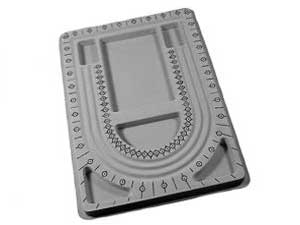
A necklace matching the new blouse or the new costume, but you do not know exactly what accessories are needed and how to attach a jewelry closure?
Here you will find a list of the necessary accessories and the tools to make a chic bead chain like a professional. In our video, we will show you step by step how you can do that.
We also provide you with information during the video, what you should be aware of, what problems might arise, and how you can solve them yourself....
2. Jewelry wire
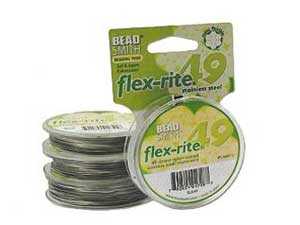
On jewelery wire or jeweler wire, as this is also called one should in no way save. The cheapest option would be a nylon tape, but after a few weeks or months it can happen that the tape rips and all the beads roll over the floor. Therefore, we recommend a jewelery wire, which consists of fine, intertwined stainless steel wires and is covered with a nylon jacket.
There are also differences in quality and strength in the jeweler wire: the cheaper variants consist of 7 wires, the more expensive of up to 49 individual stainless steel wires. The standard size in the 0.35-0.45 mm thickness and this wire can be used for most bead chains. Only if you want to work with very small or very large beads, one should then use a jewelery wire with 0,31mm or even 0,18mm thickness for small beads, 0,61mm for larger and heavy beads.
3. Bead stopper mixed
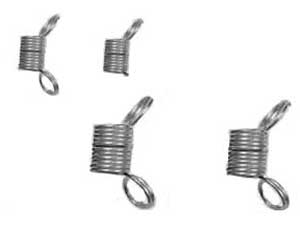
These pearl stoppers also quickly become an indispensable helper once you have worked with them. Since you usually want to place the bead chain around the neck to check the correct length, it is very easy for one of the wire to slip out of the fingers and the beads roll off.
Mostly, of course, under a cabinet or similar. Just for that, the pearl stoppers are made, which we offer in 2 sizes, depending on how big your beads are being processed.
One simply clamps on both ends of the jewelery wire ever such a pearl stopper and already nothing can roll off.
4. Accu-Guard horseshoes, Crimp beads small, crimp covers and jumprings
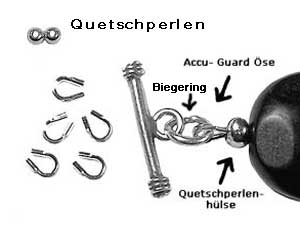
Here we come now to the important accessories, which we need, in order to attach a jewelry lock in the professional way to the bead chain. We used to use a simple snare to mount the closure, but we also use a wire loop, also known as the AccuGuard loop, which is shaped like a small horseshoe and through which the wire is led to the loop. The advantage of this is that the wire is protected not only at this point, but also provides good stability. At this wire loop, we fasten a part of the jewelry closure with the help of a bending ring, which can be bent up and again. To do this, place 2 flat-nose pliers right and left next to the opening in the bending ring, then push one side forward, the other backwards to open the ring. After the wire loop and the ring have been hooked up, the bending ring is closed by pressing both sides back into the original position.
5. Double Notch Crimp Plier
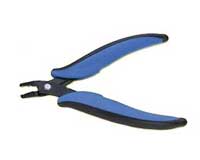
The crimping bead is located within the crimped bead sleeve. Using the crimping bead, the formed loop is fixed by crimping the crimping bead with either a flat-nose plier or a special crimping pliers.
We recommend using sterling silver squeeze beads as silver is softer and the risk of damaging the jewelery wire is considerably lower than using hard metal quill beads.
6. Jewelry Clasps
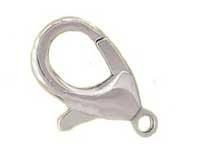
The choice of the matching jewelery closure is a matter of taste. Some prefer a magnetic closure, which can be used to close a chain very easily, but it is always a risk, since this closure can also be accidentally opened. Some like toggle closures, which are well suited for heavy bead chains.
We recommend here Stainless Steel Lobster Claw Clasp 13mm, Which are very safe, but also cheap and with a small, but well-reachable pin to open the shutter. If you use high-quality and expensive pearls, it is also possible to use a sterling silver jewelry. This is also a matter of taste and left to everyone.
7. Flat nose plier for jewelry
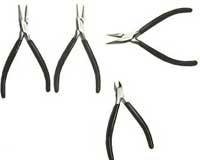
Jewelry p liers have the advantage that the jaws of the tongs are smooth and therefore, e.g. The bending rings are not damaged so quickly.
You can basically use any small tongs while sticking the ribbed cheeks with a strip of Tesaband. However, whoever wants to build percussions more often should have 2 flat-nose pliers or one Jewelry pliers set special.
These pliers are always needed and are indispensable helpers in the production of jewelery.
8. Beads for your necklaces
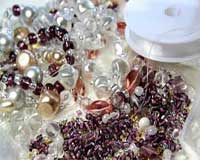
In the meantime, there is a wide range of pearls from a wide range of materials such as gemstone beads, silver beads, metal beads, wooden beads or acrylic pearls, just to name a few. The personal taste is in demand, and it also plays an important role in determining the purpose of the necklace. Whether for the evening dress, the summer holiday or every day, you will surely find something suitable for your taste and purpose. Just have a look in our pearl category and get inspired.





